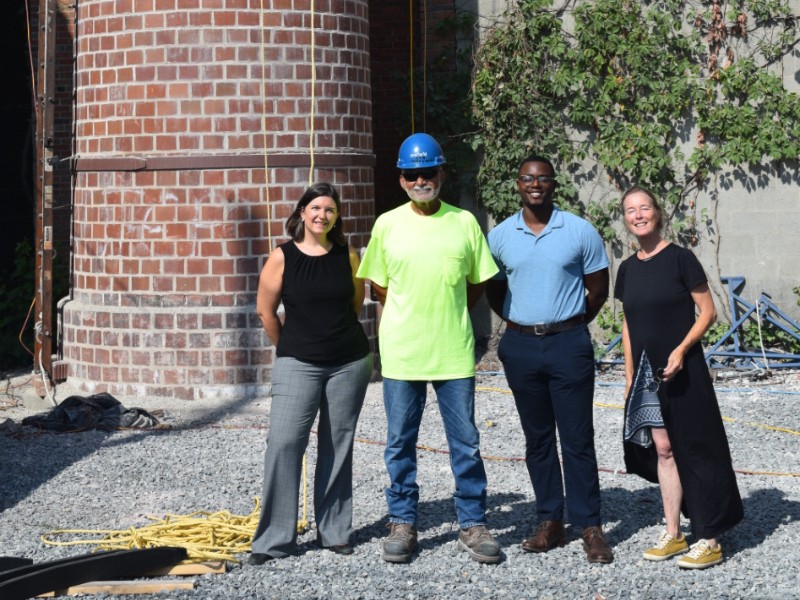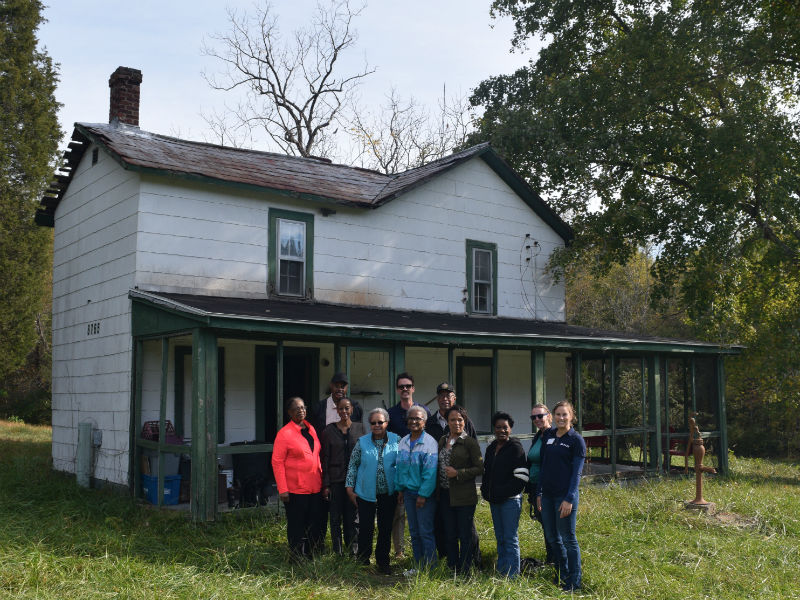With all due respect to New York Times’ editorial Board member Binyamin Appelbaum, who recently published a lengthy opinion against preservation, preservation is neither wholly perfect nor entirely harmful – there are shades of gray to this story which would have been worth exploring and considering on the pages of one of America’s true legacy newspapers.
We say that not simply because we are the preservationists and he is not (and that he is on the attack). Rather, we say that because we see the shades of gray in this complex and challenging situation – we accept and appreciate that preservation has been used as an impediment – and has a legacy of investing in certain stories and places at the exclusion of others. Yet, at the same time, preservation has been a powerful force for good and can be a tool for building just, equitable, and environmentally conscious communities for the complex years on the horizon.

Project partners at Phillips Packing House, August 2019.
PRESERVATION ECONOMICS
As an accomplished chronicler of economic conditions, we would have expected Appelbaum to take a more nuanced and academic approach, especially considering the powerful and well-studied economic power of preservation. In fact, just a few weeks ago, Place Economics released the latest report on the broad value of preservation to communities – statistics Appelbaum would have been wise to consider – such as these gems:
- Historic Districts Create Jobs: Instead of stymieing growth or limiting change, preservation is creating countless jobs across the nation. In New York City, where the Times is based, more than $800 million is invested annually in historic buildings, creating jobs for 9,000 New Yorkers and providing paychecks of over $500 million each year. The story repeats itself over and over again in cities large and small across the nation.
- Historic Properties Retain Value: As a journalist who has covered this issue extensively, Mr. Appelbaum also seems to have missed the point that in the nearly 20 cities studied, foreclosure was 20% lower in historic districts. Of course, Mr. Appelbaum might suggest that as Place Economics noted, “Well, those historic neighborhoods are all rich, so those people could weather the recession.” Again, according to the most recent research and other reports, that’s just not the case. Place Economics explains, “In every one of those cities [studied] – Indianapolis, Miami/Dade County, Pittsburgh, San Antonio, Raleigh, Savannah, and Nashville – while there are some wealthy historic neighborhoods, there are also numerous neighborhoods that are the opposite of wealthy. In nearly every one of the less prosperous neighborhoods, the foreclosure rate was still less than the rest of the city.
- Historic Districts Provide the Density Cities Need: Returning to the most recent data compiled and published a few weeks ago from Place Economics: “A common criticism of historic preservation is that it prevents increased density, and critics claim that preservation is in opposition of new developments that would provide needed housing units. [In Nashville and many other cities] this claim is not true. . . First, historic districts only cover 6% of the land area of Nashville, there is plenty of space elsewhere in the city beyond historic neighborhoods. Second, historic districts are disproportionately absorbing Nashville’s population growth. Third, historic districts are on average the densest parts of the city. In fact, these areas are home to 4,828 people per square mile, 1,600 more than residential neighborhoods in the rest of the city. Density is needed in Nashville and historic neighborhoods are providing it.
- Historic Districts Are a Critical Tool in Combatting the Climate Crisis: Here, the research is overwhelming and conclusive: older buildings are greener. Period. Study after study – from Maryland to New York City find it over and over again – but here’s a few of the strongest findings:
- In Maryland, a study funded by the Abell Foundation compared the differences in environmental impact of rehabilitating a 50,000 square foot historic industrial building to building a new structure at the edge of town. Among their findings in favor of rehabilitation were: a 20%-40% reduction in Vehicle Miles Traveled; reduced travel-related CO2 of 92-123 metric tons; retained embodied energy of 55,000 Million BTUs; greenfield land preserved 5.2 acres; less demolition debris in landfill of 2.500 tons; $100,000 value of natural resources saved; and infrastructure investment saved of between $500,000 and $800,000.
- Again, quoting from Place Economics latest research, in New York City Mayor Bloomberg’s study found that “contrary to conventional wisdom, in fact the least energy use per square foot was found in buildings constructed more than 70 years ago. For multi-family properties, a structure built since 1980 used nearly 13% more energy per square foot than did an apartment built prior to 1920. While the energy efficiency has improved for buildings constructed over the last 30 years, still an office tower built since 1980 uses 33% more energy per square foot than one built nearly a century ago.”
CLEAN ENERGY
And, most perplexing of all, is that Appelbaum would take up precious space in the columns of the New York Times to complain about a situation largely resolved.
Here’s an important update: hundreds, if not thousands, of historic districts now allow solar panels; it’s now simply a discussion about the placement of installed panels to minimize visibility. In fact, some states, like New York, incentivize their placement through existing historic tax incentives.

Solar panels on a historic flat roof. Photo by Maryland Historical Trust.
INTANGIBLE GOOD
These, of course, are the hard facts – but there’s something intangible to the work of preservation which we fear Appelbaum has missed entirely. When he suggests there is nothing historic about his Capitol Hill neighborhood (really?) but then goes on to explain, “Historic preservation, in practice, is not about preserving history. It is about preserving the lifestyle of an affluent urban elite” he is tragically missing the point.
When preservationists cherry-pick white, affluent neighborhoods for historic designation – we miss the broader aspects and nuances of history. We miss the rich African American story of survival and community that is so much a part of Washington, DC’s story beyond the domes and columns.
Applebaum tells us that, “There are buildings that should be preserved because of their historic, cultural or aesthetic significance,” but then goes on to remind us that “there aren’t many.” This argument would find many friends in the preservation movement of a half-century ago when the sublime and pristine was selected over the places of everyday people. This is the argument that allows African American neighborhoods to be bulldozed while affluent neighbors appreciate all the economic and environmental benefits we noted.
Preservation can always improve – we would be the first to admit that – but to suggest this critical tool is somehow an albatross or impediment to cities is disingenuous at best for an accomplished journalist like Appelbaum.
Next time you head north across the DC boundary line, let us know – we’d be glad to show you the good preservation is accomplishing across our state and many more just like it.

